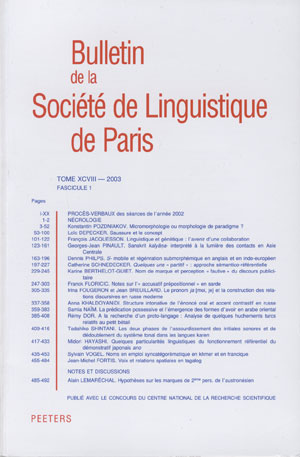 previous article in this issue previous article in this issue |

Preview first page |
Document Details : Title: Mouvements et clonages de voyelles en motlav Subtitle: Entre phonologie et morphologie Author(s): FRANÇOIS, Alexandre Journal: Bulletin de la Société de Linguistique de Paris Volume: 94 Issue: 1 Date: 1999 Pages: 437-486 DOI: 10.2143/BSL.94.1.2002485 Abstract : Mouvements et clonages de voyelles en motlav: Entre phonologie et morphologie Le seul article consacré à ce jour au motlav (Kasarhérou 1962) relevait, à la suite de Codrington, le phénomène de la copie vocalique: certains préfixes verraient leur voyelle systématiquement assimilée à celle du radical — ex. na- + vôy > nô-vôy. Nous montrons d'abord que cette règle ne concerne que la moitié du lexique, les radicaux de forme CV-, tandis que les autres (en CCV-) remplacent cette voyelle clonée par une voyelle fixe, sans copie. Après une hypothèse diachronique pour expliquer cette bipartition du lexique en deux grandes classes morphologiques (CV- vs. CCV-), le système phonologique est réanalysé en synchronie, suggérant de nouveaux outils théoriques pour représenter les faits observés. Ainsi, dans une approche autosegmentale, la notion de «phonème flottant» est réactualisée pour rendre compte du comportement de ces préfixes, et s'avère également féconde pour expliquer un autre phénomène du motlav, le transfert vocalique — ex. na- + hinag > ni-hnag. Enfin, l'insertion syllabique (mtig > mitig) donne la clef de tout le système, en permettant de transférer parmi les règles phonologiques des formes qui semblaient d'abord relever de la morphologie. Vowel Shifting and Cloning in Motlav (Vanuatu): Between Phonology and Morphology In his first account of motlav grammar, Codrington (1885), followed by Kasarhérou (1962), described the phonological rule of «vowel shifting»: a number of prefixes change their vowel into that of the following lexeme, e.g. na- + vôy > nô-vôy. We first show that this rule only accounts for half of the lexicon, namely CV- roots, whereas for CCV- roots no change occurs, leaving an unvarying vowel instead. After discussing a diachronic hypothesis in order to account for these two distinct morphological sets (ie CV- vs. CCV-), we try and reanalyse the whole system synchronically, thanks to newly defined theoretical tools. For instance, our choice of a multi-linear approach allows us to take into consideration the notion of «floating phoneme», in order to account for the behaviour of these prefixes; and the same notion appears to be efficient in analysing «vowel transfer» (e.g. na- + hinag > ni-hnag), another phonological rule of the same language. Last but not least, the rule for «syllabic epenthesis» (e.g. mtig > mitig) is the key to the whole system, through which certain so-called morphological categories prove to be entirely derivable from phonological patterns. Nok hohole gôh bi-tiy gatgat to-Motlav, so amag kêy hoholeqeleave, ba nê-dêmdêm nan yatkelgi na-hav Na-myôs mino, so nok so kaka lolmeyen bi-tiy gatgat to-Motlav so qele ave, tô no ta-yav goy ni-diksoneri mey nê-wê. Codrington kê mal kaka te mu-n tô aê, ba et qêt qete, togoy hip se. En tô gôs kê, nê-vêvêhiy mino qele gên, so: no-hohole del no-no-ngên, wô ba-hav na-qtêqtêg nan ne-tegtegha geh? Qe so, gên ôl so «nok van tot na-lêt» (tiwag mi «na»), ba tô «no me-gen tô nê-lêt» (tiwag mi «nê»). A so, yatkel hohole susu (qele «na» en), yatkelgi gên so ôl en, nô-tôtê-n ni-tegha den no-hohole mey vitwag nan (na-lêt, si so na-vnô, na-gmel, na-lo), ba yatkelgi se, gên yonteg so haytêyêh êwê qele no-hohole mey atgiy (nê-lêt, nô-vôy, ni-sil, ne-gengen). Ba no-hohole susu nan, gên so vav so ni-tiy kê mey ave? «na» si so «nê»? Ne-meh a ne-meh. Tô nok dêm lok so ige to-Mot kêy vav na-mu-y qele ave, ige del ta-Bankis kêy vav na-mu-y qele ave geh, tô nok dêm sas ê-gên: so no-hohole no- ngên ma-van me ave, ba ige bôbô no-ngên amag kêy hohole qele ave. A so: yav bah /mtig/ en, ba gên tê-dêm sas towoyig vêh so na-ha-n vitwag «na-mtig», ba na-ha-n vitwag «nô-tôti mitig». Tô no ta-galeg vêh nô-bôk mey haytêyêh galsi mi ni-tiy gatgat no-ngên. |
|


